
I have recently posted a recipe for gluten free rhubarb crumble and one for lactose free custard in quick succession. The two are meant to be together, after all. I don’t want my dairy free friends to miss out, though, which is why I have developed this dairy free custard recipe. It is a little different to the lactose free version, incredibly good and deceptively dairy free.
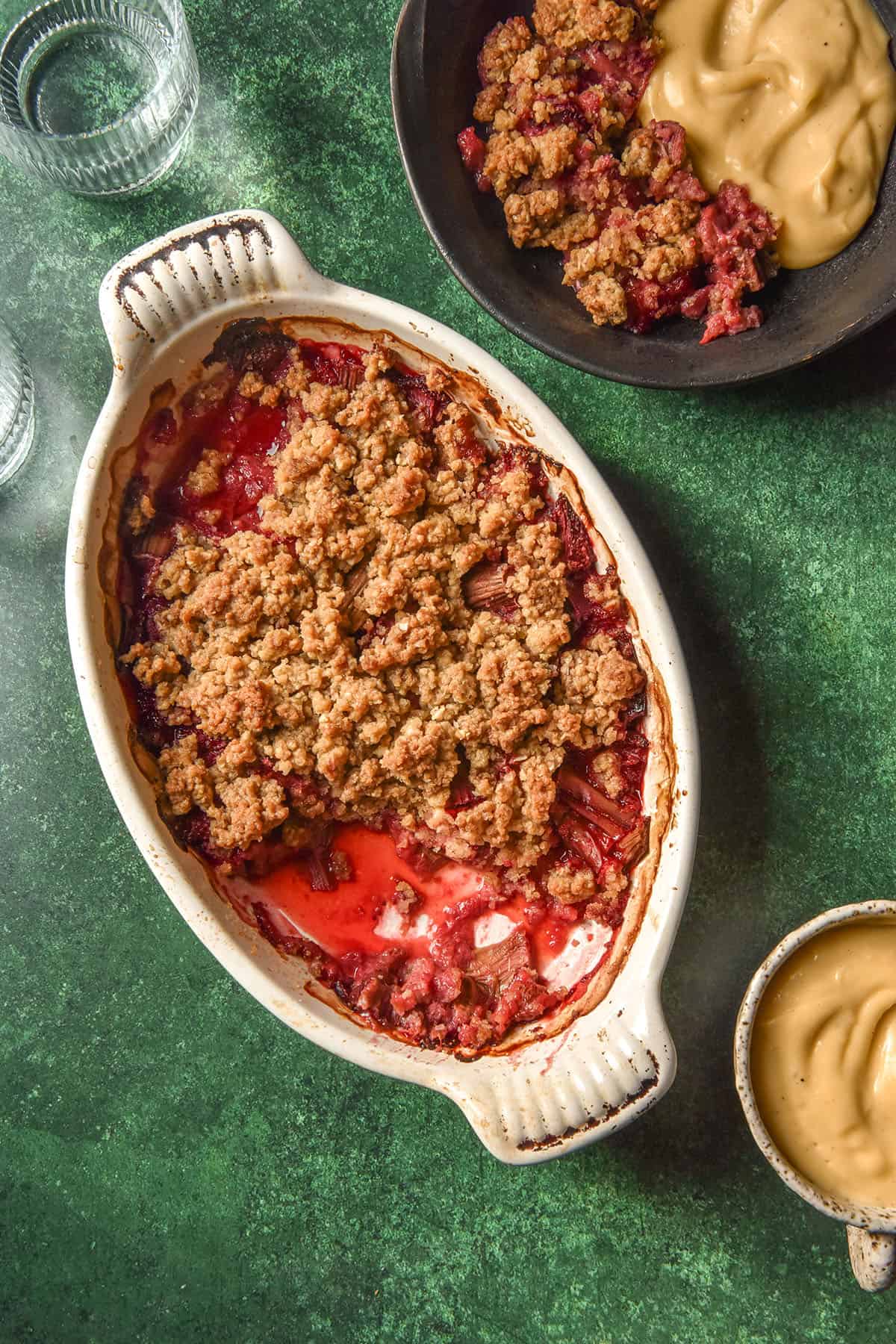
Dairy free custard recipe
This delicious, rich and creamy dairy free custard recipe is made with dairy free cream (or milk) eggs, cornstarch and sugar. It is quick and easy to make and endlessly customisable according to your preferences. Serve it with a delicious crumble or winter dessert and nobody will even know it is dairy free.
Notes on the dairy free cream or milk
Initially, I tested this recipe with rice milk. I had planned to make a milk based custard and wanted a relatively neutral milk to add bland creaminess. I have to say, I found the results underwhelming. Sure, it was a nice creamy texture, but the taste of rice milk remained.
I was inspired by my vegan Ninja Creami vanilla ice cream recipe to try using vegan cream instead. The result is a neutral, creamy and delicious custard that you barely notice is dairy free.
So, I highly recommend using vegan cream in this recipe. I have included extensive notes on the variety I used (Flora plant cream) below. This recipe does work with other plant milks, but they impart their own flavour. If you want a neutral custard, vegan cream is the way to go.
If you want to use a plant milk, I recommend adding extra vanilla extract or vanilla bean paste and a pinch of salt to help disguise the flavour. Adding 25g of vegan butter at the end also helps provide some richness.

Vegan cream notes
I used Flora plant cream in this recipe. This isn’t sponsored, just genuine appreciation for a great product. The plant cream here in Australia contains 30g fat per 100ml. This is roughly on par with regular thickened cream, which is generally around 35g fat per 100ml.
The Australian version uses the following ingredients: ‘Lentil milk (water, lentil Protein (1%)), vegetable oils (coconut, canola),sugar, modified corn starch, emulsifiers (sunflower lecithin, sugar esters of fatty acids, mono and diglycerides of fatty acids), stabilisers (guar gum, locust bean gum), natural flavourings, salt, colour (beta-carotene).’
If you’re based overseas, use a vegan with similar ingredients and proportions to the above for best results. Although I haven’t tested the versions overseas, they do seem to be very similar to the variety sold here in Australia.
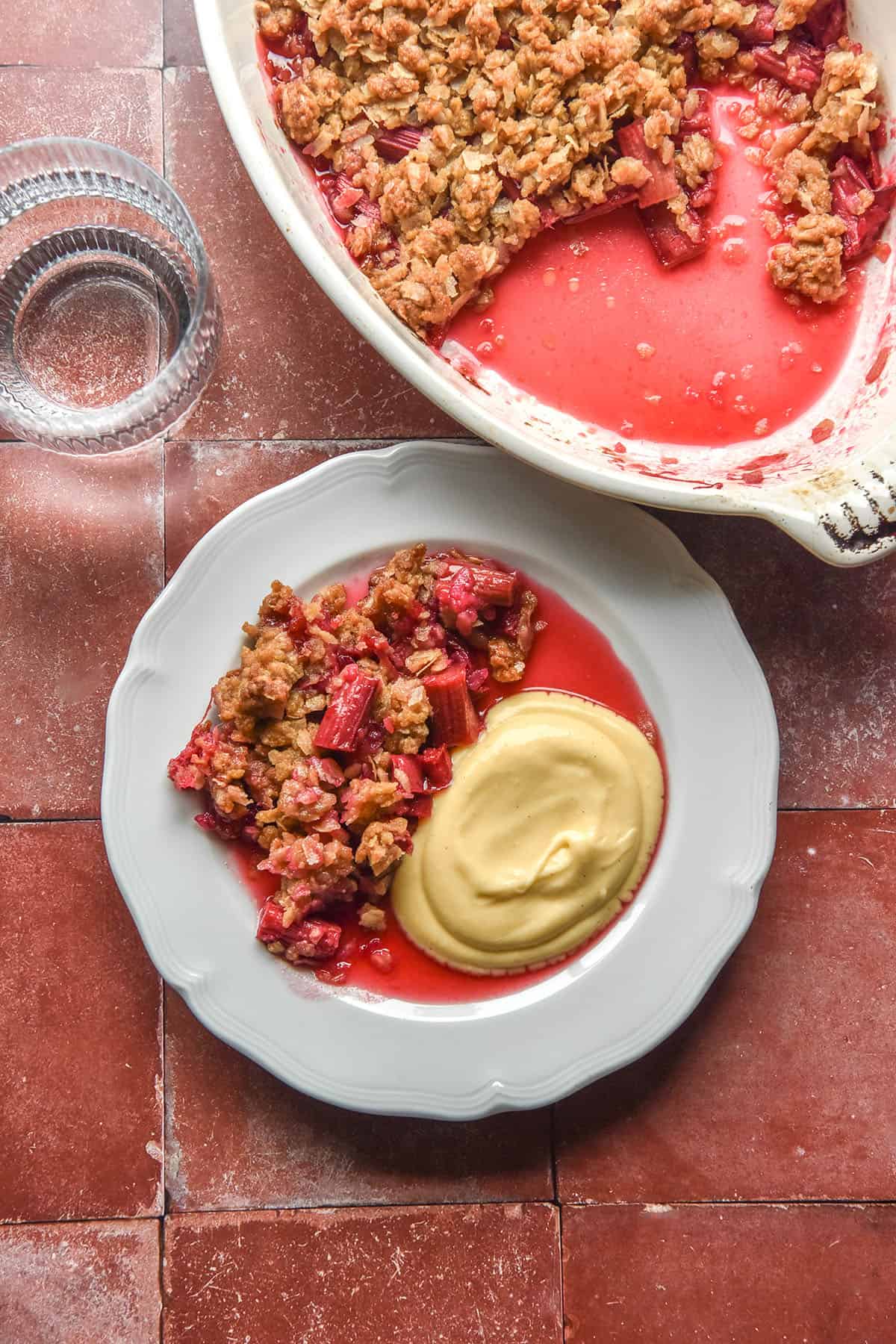
Vegan cream for international readers
In the UK, there are two varieties of Flora plant cream – regular and double. You want to stay as close to 30g per 100ml fat as possible, so choose the double cream variety.
In researching, I came across Elmlea brand plant cream which also has a very similar ingredients list to Flora Plant cream. Make sure you choose the 100% plant cream version, though, as there seems to be a buttermilk version with a confusing name – ‘alternative to double cream.’
In America, it seems as though there is some Flora plant cream available in a limited capacity. However, it also appears that there is a variety from Country Crock that has similar ingredients to the Flora plant cream I used. It contains 30g fat per 100ml. I couldn’t tell if Canada has Country Crock or Flora plant cream available because their supermarkets have blocked international users from browsing lol.
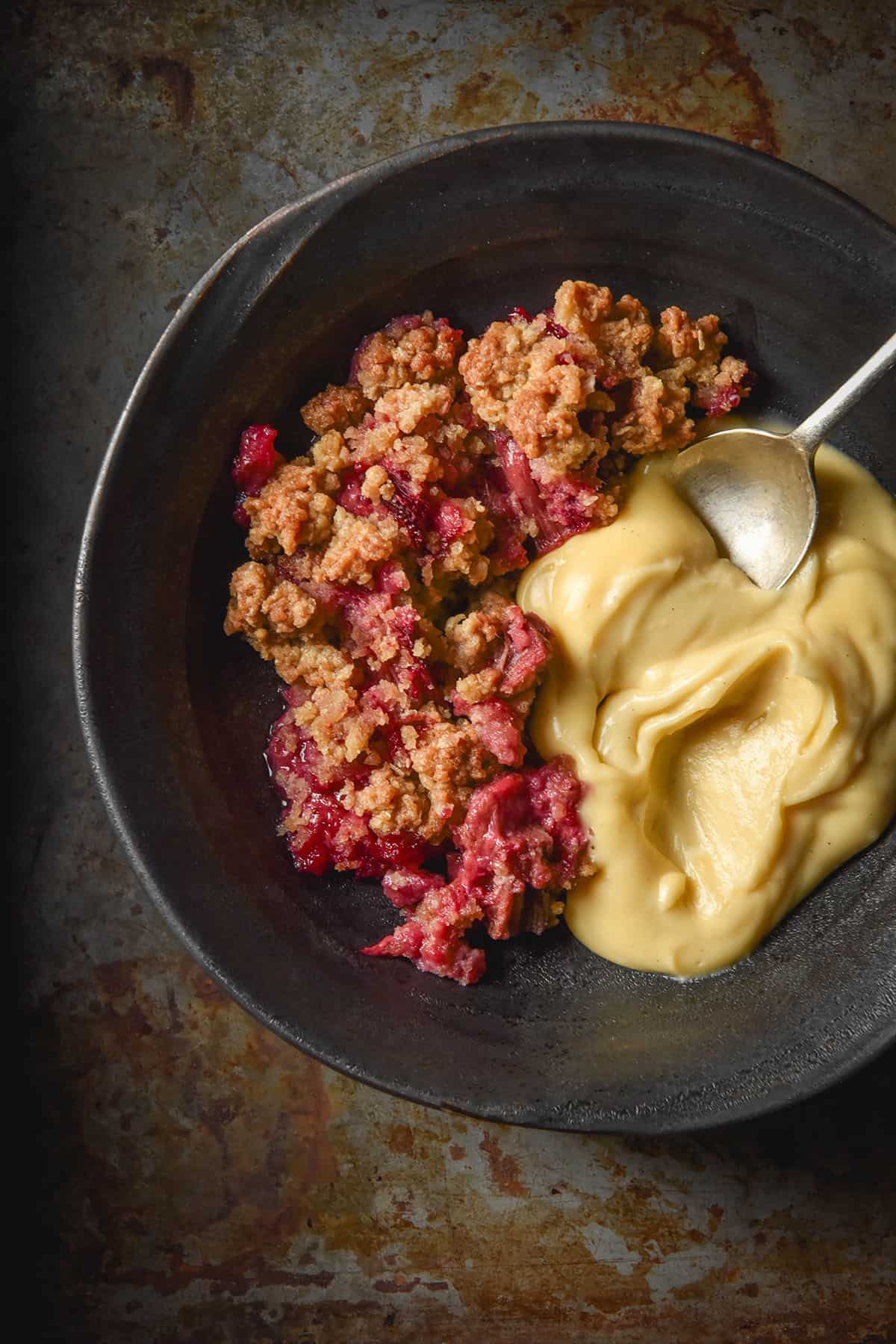
Tips for your dairy free custard
Corn starch is our thickening agent of choice for this custard. While there is discussion about whether starch is traditional to custard, it makes the process so much easier. Not only does it help thicken the custard, but it in turn ensures the eggs don’t get overcooked by a lengthier cooking time.
If you can’t have cornstarch, my next recommendation is potato starch. I find it the next best thing in thickening sauces. My past experience using tapioca flour in sauces was underwhelming – they had a gloopy texture.
You can add a little less starch for a thinner custard. This custard is a medium to loose pudding consistency, depending on how long you cook it. You could also try using 4 egg yolks as opposed to 2 whole eggs. I haven’t tested this but I did test it in my lactose free custard recipe. It makes for a much thinner and slightly more yellow custard.
The colour of your custard depends a little bit on your eggs. The more vibrant the yolks, the more vibrant the custard.
If you’re using the plant milk option, choose a neutral but creamy milk. I found that rice milk tasted too obvious, but that might be because I was also testing my lactose free custard at the time. Hence, a fairly stark comparison.
If you’re making a milk only custard, I recommend adding 25g vegan butter at the end and whisking it in. This adds a creamy richness that is missing without cream.
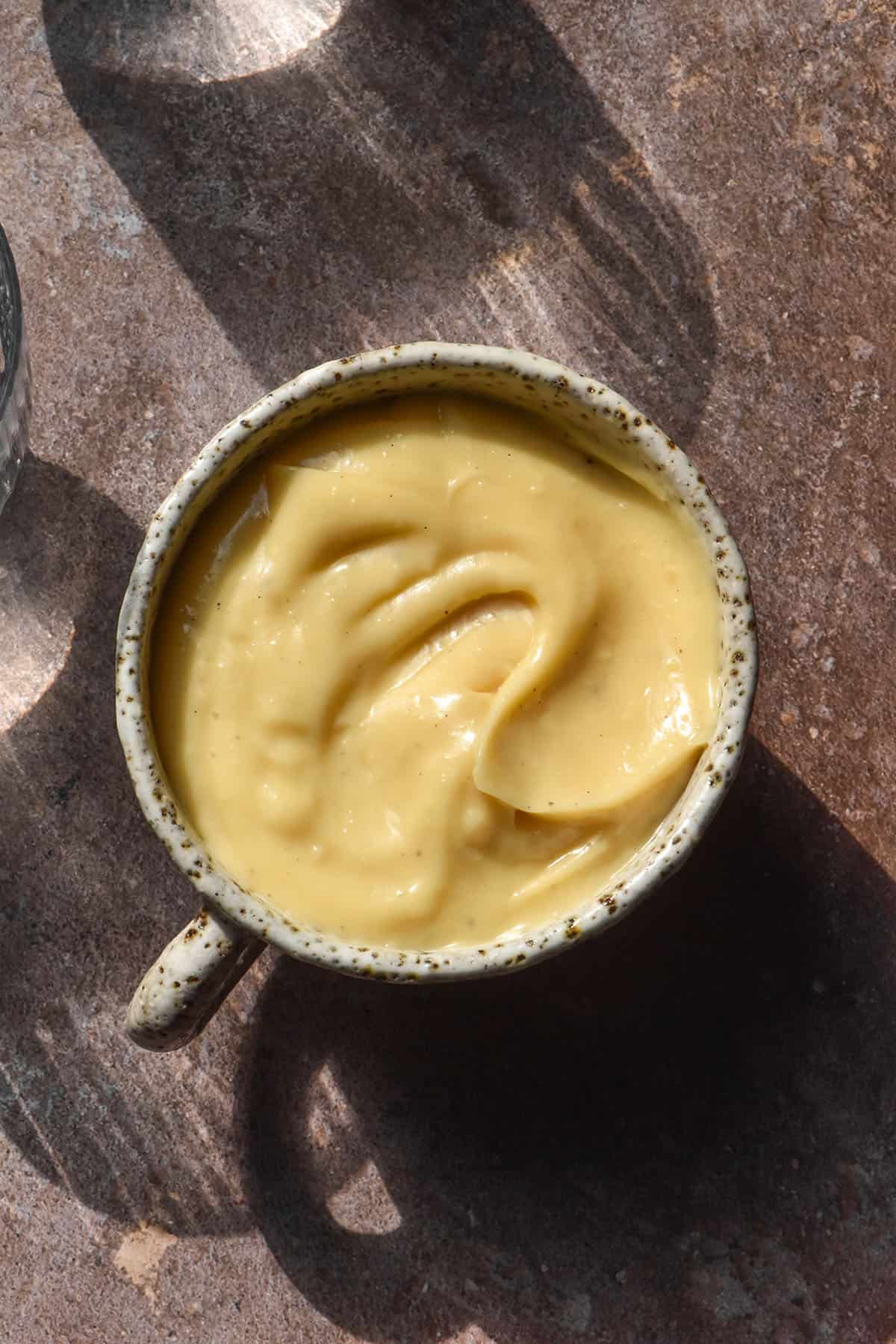
More dairy free gluten free dessert recipes
- Gluten free vegan sticky date pudding
- Gluten free rhubarb crumble using vegan butter
- Gluten free dairy free chocolate cake
- Gluten free vegan brownie cookies
- Gluten free vegan cinnamon rolls without yeast
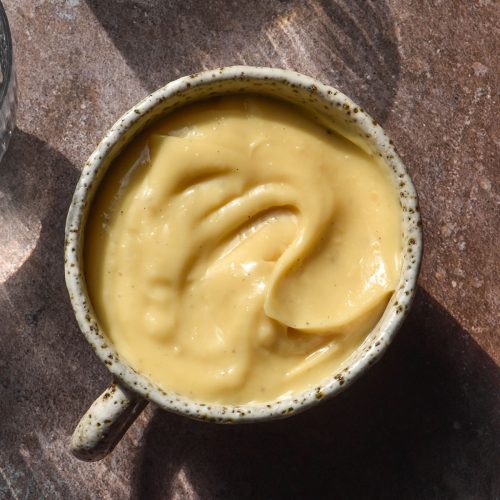
Dairy free custard recipe
Ingredients
- 30-50 g cornstarch (see notes)
- 40-60 g caster sugar (see notes)
- 2 extra large eggs (45-55g per egg, weighed out of shell)
- 250 ml (1 cup)* Flora plant cream (see body of post for extensive notes)
- 250 ml (1 cup)* water
- 1-2 teaspoons vanilla bean paste
- Pinch of salt
Instructions
- Whisk together the cornstarch and caster sugar in a medium mixing bowl. Ensuring the cornstarch is completely whisked into the sugar will ensure you don’t have lumps of cornstarch in your custard. This is important as the cornstarch doesn’t dissolve into the egg whites easily, so it needs to be combined prior to adding them.
- Whisk in the eggs and continue until mostly smooth. Set aside – the cornstarch should dissolve while you work on the rest of the custard.
- Place a tea towel on the bench, get your whisk ready and set aside a medium/large pouring or measuring jug.
- Place the plant cream and water in a medium saucepan over a low-medium heat. Heat the mixture, whisking intermittently, until it is hot to the touch but not boiling or simmering.
- Turn the heat off and ladle half of the hot dairy mixture into your pouring jug.
- Place the bowl of egg mix on the tea towel (to stop it moving) and whisk the mixture as you very slowly drizzle in the hot dairy mixture.
- Continue drizzling and whisking until you have used all the dairy in the jug. Tempering the eggs like this brings up them to a warm temperature gradually so that they don’t split and you get a lovely smooth custard.
- Pour the mixture back into the empty pouring jug. Return to the stove and repeat the process – drizzle your egg and dairy mixture into your saucepan with the remaining dairy as you whisk. Once all of your mixture is back in the saucepan, turn the heat to low.
- Continue to whisk and cook for about 3-5 minutes. Make sure to get the corners of your pot, as custard can settle and overcook.
- As you stir, the mixture should thicken and coat the back of a spoon easily. The custard should thicken to a point where the whisk leaves tracks in the surface and it has the consistency of a thin to medium thickness pudding.
- Continue to cook on a low heat until your custard thickens. It continues to cook and thicken as it cools, so If in doubt, take it off the heat. You don’t want to overcook the eggs and curdle your custard.
- Cover your custard with a film of cling wrap once it has finished cooking. This will prevent it from forming a skin. If your custard does form a skin, you can simply whisk it in (although you might get a few little lumps). You can sieve the custard to remove the lumps if you want to.
- Serve warm and transfer any leftovers to an airtight container in the fridge. Use within a few days. I haven't tested freezing this recipe.
Notes
- I have found the best substitute for cornstarch to be potato starch.
- Use less cornstarch for a thinner custard and more cornstarch for a thicker custard.
- See the extensive notes on the plant cream in the body of the post. You can also use regular plant milk if you can’t find the Flora plant cream or international equivalents (see notes in body of post). It will taste more akin to the milk you’re using as opposed to a dairy based custard.
- I also find it helpful to add 25g of vegan butter at the end to add some richness to an otherwise light custard (this is only if you are using plant milk instead of this Flora plant Cream).
- The colour of your custard depends on the colour of your egg yolks. Egg yolks with a deep orange hue will create a brighter custard colour.
- 30g of caster sugar creates a subtly sweet custard which is perfect for me. I know that tastes for sweetness differ globally, which is why the range for sugar is there.
- If you are using this recipe to make Ninja Creami ice cream, I recommend the 60g sugar option.
- I have a lactose free custard recipe here.
- If you are looking for a tart filling, I recommend using the crème patissiere in my cookbook Intolerance-Friendly Kitchen. It is designed for that purpose and there is a vegan version as well.

No Comments